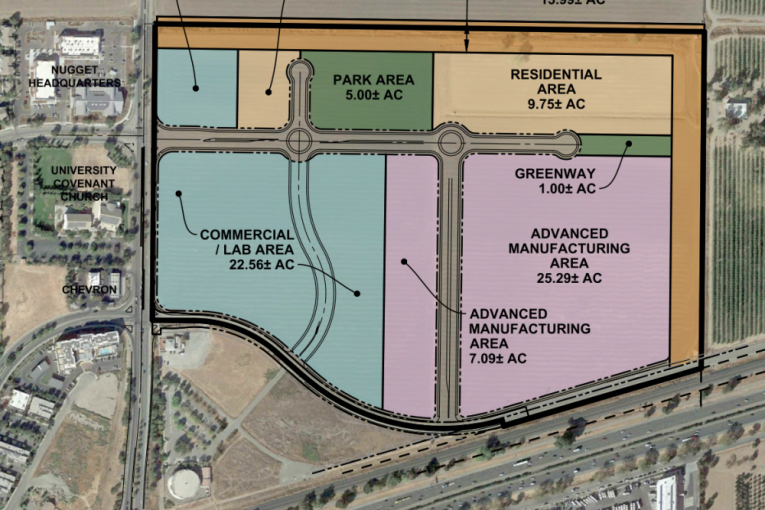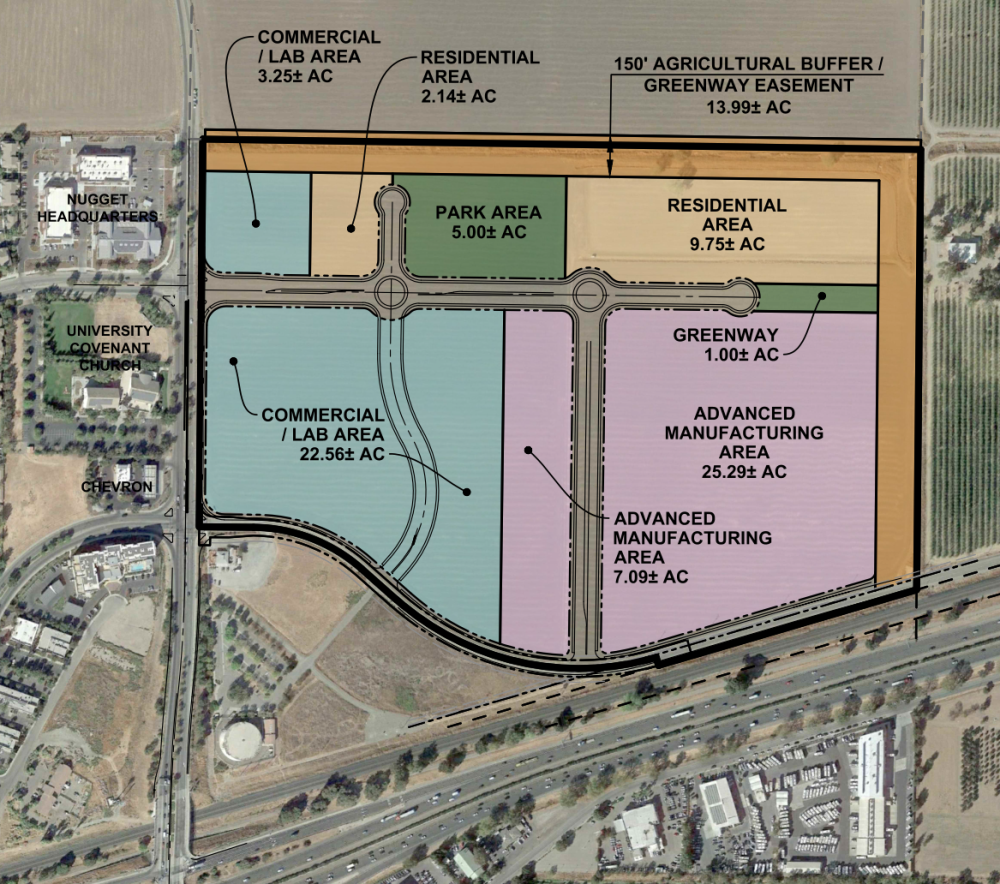
 By David M. Greenwald
By David M. Greenwald
Executive Editor
Davis, CA – In a way, Wednesday night probably went as smoothly as the DiSC 2022 team could have hoped—there was general support for the project by the Planning Commission, no one opposed moving forward, the meeting ended just before midnight and only 41 people called in to public comment.
The team starts this process having lost the election just 14 months ago, but with a much smaller project that figures to have a much smaller traffic impact. In addition, the team is hopeful with a somewhat different landscape now than 14 months ago and more ability, at least presumably, to go door to door—and with more students in town, they have a better chance this go-around.
Still, I see three additional potential pitfalls that are avoidable by the development team.
The first one is the issue of a grade-separated bicycle crossing. The plan at this point is not to build it. They would create land for it, but the city would need  to find the funding to build it. That’s a big mistake.
to find the funding to build it. That’s a big mistake.
I get that this project is considerably smaller than the previous version, but at just over 100 acres, it’s actually the same size as Cannery. There is comparable amount of housing. Moreover, both projects are separated from town by a major arterial roadway. The lack of a second crossing almost ended up with the defeat of Cannery on a 3-2 council vote and this project not only needs to win 3 votes on council, but 50 percent plus one of the voters.
I have already seen some of our commenters here suggest that they would vote against this project without that crossing.
Personally, I would rather see them put their resources into the TDM (Travel Demand Management) and the road redesign rather than a grade-separated crossing, but as an observer of recent history, I think it would be a grave tactical error not to address this issue up front.
This is an issue that most people in Davis will understand and if the opponents attack on it, it will cost votes. This is an easy way to shore up support for the project—easy but not necessarily cheap.
Second, I understand their point on the Project Baseline Features. In most ways, I agree with it. But, politically, it is not a good idea.
Matt Keasling noted that there were two different types of concerns.
He said, “The first was concern that things had been removed from the baseline features that had been there previously, and then secondarily concern that things that had been requested to be added to baseline features were not added.”
He responded, “We made a decision to remove certain level of detail from baseline features and that it was very intentional.”
There is a belief that if things are not in the baseline features, it’s not going to happen. He felt like some of the baseline features were too specific and got too fine in terms of the level of detail.
“We had serious concerns that that level of detail was resulting in very long and over-encumbering baseline features that were confusing people,” Keasling explained.
What they need to do is have enough specificity to say “if you say, we’re going to build an innovation center, you’re going to build an innovation center and not then get subsequently annexed into the city and immediately request to change the general plan designation to a hundred percent residential, right?”
He said, “It ensures that that cannot happen and the council does not have the ability to grant a general plan amendment or a rezone that is inconsistent with what you told the voters you were going to build.”
All of that makes sense, but it doesn’t work in Davis. People do not trust developers. People do not trust that the current or future councils will hold them to their promises. They have seen the wiggle room that Cannery got and, even though the council didn’t support most of it, it has contributed to the overall distrust.
I think Keasling is correct that there needs to be more flexibility with the baseline features so that they can develop and actually build an innovation center, which is not the same thing as building a housing project. But the major points and promises still need to be locked into the baseline features—not just in the DA or the CEQA mitigation measures.
I did point out in the comments earlier this week that we don’t actually know how enforceable project baseline features are because we have still not built out a Measure J project and have never seen a challenge to baseline features arise, potentially having to go to court.
Finally, traffic is going to be a major issue in the Measure J election. Right now, the DiSC 2022 project “would be required to plan and implement roadway capacity and operational improvements on Mace Boulevard and CR 32A.” Improvements have been identified at seven specific locations (there were 10 in the original DISC project). The applicant would be required to prepare a Mace Blvd Corridor Plan.
What concerns me is this: the “precise timing and nature of improvements would be determined by focused traffic studies conducted prior to each phase of development.”
From a policy perspective that makes sense—there will be a lot of moving parts and uncertainty and they need to be flexible and responsive to problems.
On the other hand, you need to get votes in June and that means you have to convince people that you aren’t dooming half the city to sitting in traffic for an extra 20 minutes because of this project.
As we noted from the 2016 election for Nishi, that’s a tough task even when you have a workable plan. I don’t think “to be determined” is going to convince skeptical voters to give it a shot. You need to lay out a plan and it again needs to be enforceable.
This was a 52-48 vote last November against the project. Over 60 percent of those living in near vicinity of the project opposed it. The reduced size will help, but they can solidify their chances by doing a better job of assuring the public that they will address these issues.


I agree with this article in its cautionary tone for those seeking to build — the developers should take heed the details of this article, even as they have watered down the details of the baseline features therein.
[edited]
It took some digging but I found a key letter from the DISC developers to the City of Davis Association of Private Motor Vehicle Sellers and Suppliers:
Dear CDAPMVSS,
Following are what we plan on the primary characteristics of DISC in regards to your organization’s mission:
1 – Most of the day a connection by private automobile to Downtown Davis, UC Davis and West Sacramento will be extremely convenient and fast.
2 – A private automobile will be required to conveniently and quickly travel to Pioneer Elementary, Nugget (on Mace) and surrounding stores, and of course to the Davis Auto Mall (identifiable by its bicycle logo from I-80).
3 – Travel by cycling and walking to Harper Junior High and Korematsu Elementary will be significant until a crossing guard is killed and two students are injured at the intersection of Alhambra and Mace. In response we plan to place small posters at bus stops in the area to direct drivers to slow down. We were going to pretend to compromise and “return” the construction of a grade-separated crossing of Mace but in the end the Council didn’t ask for it.
4 – Travel by automobile to schools outside of east Davis will be the majority mode, especially to Davis High School, and drivers will threaten students crossing E. Covell to get to Birch Lane Elementary, crossing F and 14th to get to North Davis Elementary and the high school.
5 – The TDM plan will determine that carshare is not interesting for nearly all residents who have opted to rent a parking place near their home.
6 – Caltrans has confirmed that they have no interest in assisting in building a safe and dedicated bicycle and pedestrian facility across I-80 in the vicinity of Mace, similar to their same position on the I-80 Managed Lanes project.
7 – Some residents will ride cargo bikes to Target and surrounding shops until a user is killed at the corner of Mace and 2nd.
8 – The Chevron station at Mace and 2nd will gain business.
9 – Mode share of the fare-free shuttle to Davis Depot and Downtown will be insignificant due to duration and inability to match fluctuating schedule of Capitol Corridor trains due to problems outside of their control, such as shipping traffic on the Carquinez Strait that requires bridge interruption.
Thanks, the DISC development team.